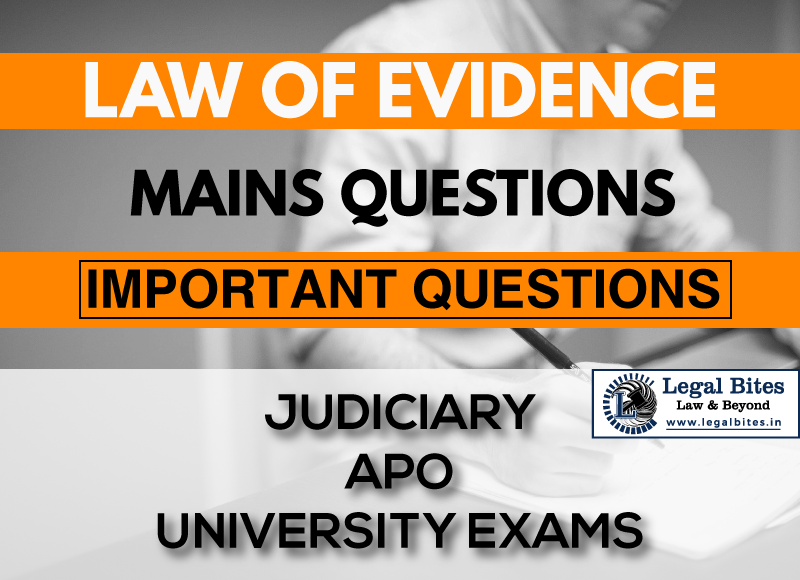Distinguish between public and private documents. How are they proved?
Question: Distinguish between public and private documents. How are they proved? Find the answer to the mains question only on Legal Bites. [Distinguish between public and private documents. How are they proved?] Answer Documents are divided into two categories: public and private. Section 74 of the Indian Evidence Act provides the following list as included under public documents:… Read More »

Question: Distinguish between public and private documents. How are they proved? Find the answer to the mains question only on Legal Bites. [Distinguish between public and private documents. How are they proved?] Answer Documents are divided into two categories: public and private. Section 74 of the Indian Evidence Act provides the following list as included under public documents: 1. Documents forming the acts, or records of the acts- Of the sovereign authority, Of official bodies...
Question: Distinguish between public and private documents. How are they proved?
Find the answer to the mains question only on Legal Bites. [Distinguish between public and private documents. How are they proved?]
Answer
Documents are divided into two categories: public and private.
Section 74 of the Indian Evidence Act provides the following list as included under public documents:
1. Documents forming the acts, or records of the acts-
- Of the sovereign authority,
- Of official bodies and tribunals, and
- Of public officers, legislative, judicial, executive, of any part of India or of the commonwealth, or of a foreign country.
2. Public records kept in any state of private documents
The public record of a Wakf deed which is a private document kept in the office of the Sub-registrar is a public document as defined in clause (2) of section 74 of the Evidence Act and a certified copy thereof is admissible in evidence; Fazal Sheikh v. Abdul Rahman Mea, AIR 19991 Gau 17.
Further, section 75 provides: Private documents- All other documents than in section 74 are private.
According to Lord Blackburn, “a public document is a document that is made for the purpose of the public making use of it, and being able to refer it. It is meant to be where there is the judicial or quasi-judicial duty to inquire”
A public document is a document that is made, where there is a judicial or quasi-judicial duty to inquire for the purpose of the public making use of it and being able to refer to it. Public documents are the acts of public functionaries, in the Executive, Legislative, and Judicial Departments of Government, including under this general head, the transactions which official persons are required to enter in books or registers in the course of their public duties, and which occur within the circle of their own personal knowledge and observation.
A document cannot be said to be a public document within the meaning of section 74 of the act unless it is shown to have been prepared by a public servant in the discharge of his official duty. The mere fact that it is kept in its copy is in the office does not lead to the inference that it is a public document.
It should be noted that registered documents evidencing merely private transactions are not public documents and must be proved in an ordinary way like other documents, Section 74 (2) refers to private documents made by private persons and kept as records in public offices to which the public generally have access. An entry in the register of power of attorney is a public document within the meaning of section 74 (1) (iii), a certified copy of which is admissible as proof of the original entry by virtue of section 65(e) of the act.
The distinction between Public Document and Private Document
Public documents as provided under section 74 of the Indian Evidence Act are documents that are prepared by public servants in discharge of their public duties. Private documents as described under section 75 of the IEA are those documents that are prepared by a person for his private interest under his private right.
Public documents are available for inspection to the public in public office during the appointed time after payment of fixed fee whereas Private documents are kept in the custody of the person to whom it belongs and is not available for general inspection to the public.
The secondary copy of the public document is to be admitted in judicial proceedings but before proving one of the conditions laid down under Section 65 the secondary evidence of the original document is not to be admitted in judicial proceedings.
As a general rule, the public document is proved by secondary evidence whereas as a general rule the private document is to be proved by original i.e. by primary evidence
The Court is bound to presume the genuineness of public documents from their duly certified secondary copy. But No presumption is made about the genuineness of original document from secondary evidence of private document except in some exceptional circumstances.
Important Mains Questions Series for Judiciary, APO & University Exams
- Law of Evidence Mains Questions Series Part-I
- Law of Evidence Mains Questions Series Part-II
- Law of Evidence Mains Questions Series Part-III
- Law of Evidence Mains Questions Series Part-IV
- Law of Evidence Mains Questions Series Part-V
- Law of Evidence Mains Questions Series Part-VI
- Law of Evidence Mains Questions Series Part-VII
- Law of Evidence Mains Questions Series Part-VIII
- Law of Evidence Mains Questions Series Part-IX
- Law of Evidence Mains Questions Series Part-X
Admin Legal Bites
Legal Bites Study Materials correspond to what is taught in law schools and what is tested in competitive exams. It pledges to offer a competitive advantage, prepare for tests, and save a lot of money.
